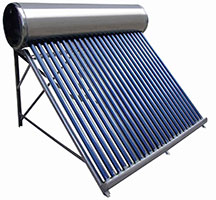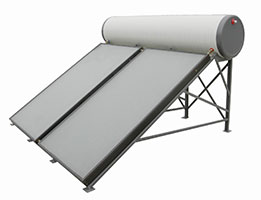Solar Water Heater Systems

Solar Water Heaters have several advantages over conventional water heating systems as they:
- Reduce electricity bills: 40% of an average household's energy bill comes from water heating.
- Save interior space: These systems are usually located on rooftops.
- Increase safety: Solar water heaters eliminate the risk of accidents in bathrooms due to electric water heating equipment and Gas geysers.
- Quick payback: On average, a good quality solar water heater will have a payback period of 2-3 years in Indian conditions.
There are two types of Solar Water Heating Systems -
1. Evacuated Tube Collector Solar Water Heater
 Solar Water Heater (ETC System) works on a simple principle
'Black body heat absorption principle'.
The principle says, 'black colour absorbs maximum heat, more than any other colour'.
Solar water heating systems using vacuum tubes made of borosilicate glass with special coating to
absorb the solar energy are called as Evacuated Tube Collector system (ETC Systems).
Solar Water Heater (ETC System) works on a simple principle
'Black body heat absorption principle'.
The principle says, 'black colour absorbs maximum heat, more than any other colour'.
Solar water heating systems using vacuum tubes made of borosilicate glass with special coating to
absorb the solar energy are called as Evacuated Tube Collector system (ETC Systems).
Evacuated Tube Collector Solar Water Heater Features:
- High quality tubes made from borosilicate glass
- No clogging/choking
- Better performance in winter and cloudy days
- Inner glass tube is coated with the world best magnetron sputtering Hi-Tech, layers of AL - N with AL base
- Vacuum jacket insulation
- Makes hot water available even on partially cloudy days
- Easy to install, operate and maintain
- Works efficiently with hard water
2. Flat plate Collector Solar Water Heaters
 Flat Plate Solar Collectors is the earlier technology used in Solar
Water Heating Systems; however they are still today the most efficient & reliable for Solar Water Heating
Systems. Under soft water conditions they have a life of 20 years & more.. Flat Plate Collectors have been
carrying the prestigious ISI Mark..
Flat Plate Solar Collectors is the earlier technology used in Solar
Water Heating Systems; however they are still today the most efficient & reliable for Solar Water Heating
Systems. Under soft water conditions they have a life of 20 years & more.. Flat Plate Collectors have been
carrying the prestigious ISI Mark..
A typical flat-plate collector is a metal box with a glass or plastic cover
(called glazing) on top and a dark-colored absorber plate on the bottom. The sides and bottom of the collector
are usually insulated to minimize heat loss.
Sunlight passes through the glazing and strikes the absorber plate, which heats up,
changing solar energy into heat energy. The heat is transferred to liquid passing through pipes attached to
the absorber plate.
Absorber plates are commonly painted with "selective coatings," which absorb
and retain heat better than
ordinary black paint. Absorber plates are usually made of metal-typically copper or aluminum-because the
metal is a good heat conductor. Copper is more expensive, but is a better conductor and less prone to
corrosion than aluminum. In locations with average available solar energy, flat plate collectors are
sized approximately one-half- to one-square foot per gallon of one-day's hot water use.

